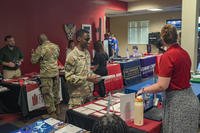CORONADO, Calif. -- For the first time, Marines and sailors teamed up to perform a beach unloading exercise using the Beach Termination Unit, in Coronado, Calif., Aug. 1-4, 2015.
Approximately 30 Marines with Bulk Fuel Company, 7th Engineer Support Battalion, 1st Marine Logistics Group, teamed up with sailors from Amphibious Construction Battalion 1 to conduct a beach unloading exercise. What made the training unique was the use of the BTU, which allows Marines to transfer fuel from a ship out in the ocean to Marines on land.
In the past, Marines have had to rely on aerial fuel delivery or government and commercial contractors to bring them fuel during operations. This process proved to be slow and sometimes dangerous. Now, with the BTU, they are able to get fuel through the ocean.
“We have to have a way to get fuel from the ship to the shore,” said Sgt. Zachary Vincent, first platoon guide, Bulk Fuel Co., 7th ESB. “So what the BTU is used for is to help regulate pressure and to transfer clean water or fuel to the units on shore.”
Once the fuel is transferred from the ship to the BTU it is then sent to the beach unloading system which has a 50,000 gallon bag for contaminated fuel and two 50,000 gallon tanks to hold the clean fuel. The system itself holds a total of 1.12 million gallons.
“If we run into a situation like Iraq, Korea or anywhere by an ocean, we can send ships in so we don’t have to contract it out. It is also extremely useful during humanitarian missions,” said Vincent. “It takes 48 hours from the time the ship arrives to when the BTU needs to be set up and we can start pumping.”
The process begins with Navy divers reckoning the area to ensure the hoses won’t be obstructed. The ship holding the fuel is equipped with metal piping that is connected to a barge, which can be up to four miles long. The hose on the ship is connected to a hose from shore. From here, the hose is buried and the last few hundred feet of hose is filled with air so it can float, making it easier to pull it onto shore.
Before it reaches the Marines on shore, it takes 140 personnel to get the hose to the BTU. Once it arrives it is up to the 150 or so Marines to transfer, contain and disseminate the fuel.
“I think the training is helpful because it makes us more valuable,” said Vincent. “We can do things that other units can’t. We will be able to do it faster and with less personnel and we can actually go anywhere where we would need fuel and do it ourselves instead of relying on government contractors and civilian contracting. It saves everyone a lot of money.”
This is the first time that the Navy has worked with Marines using this system. It also marks the first time a BTU will be coming to Pendleton.
“The whole experience has improved our relationship with the Navy,” said Staff Sgt. Oscar Delangel, operations chief, Bulk Fuel Co., 1st MLG, and a native of Moreno Valley, Calif. “It’s also a good experience for the Marines. Not only the junior ones either. Marines like myself, who have been in for 14 or more years, haven’t seen anything like this before. It’s going to really help out, not just this unit, but units throughout the country and overseas.”
Related Video
Semper Fi Always Faithful




























